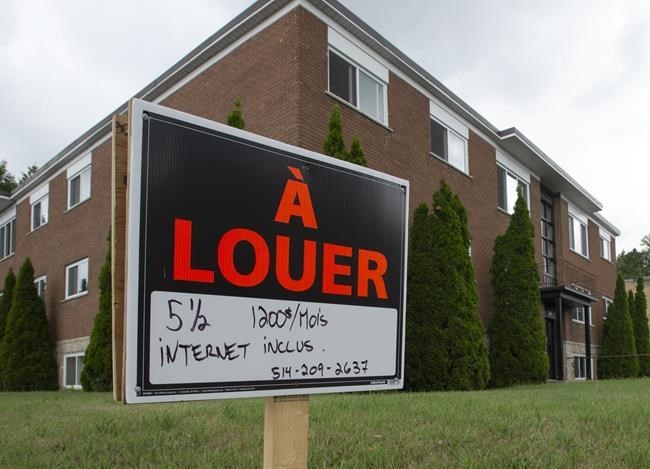MONTREAL — It isn't easy to find an apartment in St-Donat, Que., these days, much less an affordable one.
An influx of city dwellers seeking more space has caused housing demand to surge in the community 130 kilometres north of Montreal, leaving a shortage of affordable apartments for the young people it desperately needs to work in local businesses during the tourist season.
"Rental housing that isn’t too expensive? There isn’t any more, or (units) are very, very rare or not good quality," Mayor Joé Deslauriers said in a recent interview.
Most residential leases in Quebec expire July 1, resulting in many Quebecers spending Canada Day packing up their belongings and moving to a new home. The frantic rush this time of year for apartments heightens concerns over shortages and affordability that inevitably focus on big cities such as Montreal. But increasingly, even small towns and rural areas are witnessing housing crunches.
Data released by the Canada Mortgage and Housing Corporation in May shows that rental vacancy rates for apartments in cities of 10,000 people or fewer stood at 1.5 per cent — the lowest of any province. In many Quebec communities, the vacancy rate is zero, especially for larger apartments of two or three bedrooms.
Small-town officials say COVID-19 didn't create the problem but exacerbated issues that were already present. Those include a lack of traditional apartment blocks in small towns, rising home prices, the popularity of vacation rental sites such as Airbnb and the challenges of attracting developers.
Nowhere is the issue more pressing than in Îles-de-la-Madeleine, a small island archipelago in the Gulf of St. Lawrence, north of Prince Edward Island. Vacancy rates for many types of rentals sit at zero per cent, according to legislature member Joël Arseneau.
Home sale prices on the island, he said, have risen 60 per cent in the last year, adding that many of the sales are going to seasonal residents or to people who want to rent the homes for profit.
Arseneau helped put in place a crisis team earlier this year after receiving calls about some 40 people who he said would have been left "literally in the street" or forced to live in a tent during the summer. He said local authorities are still working with the Red Cross to help about half a dozen families.
Arseneau said both he and municipal officials have been working to get more housing built. A bill passed in the legislature last year has given the municipality the right to subsidize property taxes for developers who build rental housing. Another program that would allow it to subsidize construction costs is in the works.
The idea of limiting short-term rentals may eventually be on the table, but it's a tricky proposition in a place where many residents depend on the lucrative tourism sector to pay their bills.
While there's been interest from developers, Arseneau said building isn't easy in the region due to its remoteness, high construction costs, limited land and labour shortages. "We need at least 100 homes, but in the next year will we be able to build 20, 40, 50?" he said.
"It would be ambitious to say we will eliminate the deficit completely."
The situation is also serious in the Bas-St-Laurent region, where the vacancy rate for three-bedroom apartments in Rimouski, Que., has fallen to 0.2 per cent, leaving "almost no apartments for families," according to Alexandre Cadieux, spokesman for community housing group Comité Logement Rimouski-Neigette.
Cadieux said the low vacancy rate in the region on the lower shore of the St. Lawrence River means landlords can discriminate, with some opting not to rent to new immigrants or people with large families.
Catherine Leviten-Reid, an associate professor in community development at Cape Breton University, says rural communities face particular challenges when it comes to tackling housing issues. Those communities, she adds, often lack services such as homeless shelters and housing advocacy groups.
Furthermore, there’s a lack of data about rural housing and homelessness, which makes it harder for politicians and community groups to act, Leviten-Reid said in a recent interview.
“If your population size is less than 10,000, then you only have data collected on your rental housing market once every five years, and so that, as you can imagine, is a real problem,” she said.
While housing issues are complex, Leviten-Reid said solutions exist. Limiting short-term vacation rentals is one. Longer term, she said, there’s a need to build “permanently affordable” long-term rentals, likely developed by the non-profit sector.
Back in St-Donat, Deslauriers said he's considering a number of options to increase housing, including exploring the idea of non-profit co-ops. He said he's also hoping the province will step in by developing more social housing and reducing the red tape for developers to access programs that incentivize them to build affordable homes.
Deslauriers said the town's recovery from the COVID-19 pandemic depends on it.
There are hundreds of jobs available in the town, but he admits most aren't highly paid, and businesses are being forced to cut hours because they can't attract workers.
"To be able to work, people have to be able to house themselves," he said.
This report by The Canadian Press was first published July 1, 2021.
Morgan Lowrie, The Canadian Press

